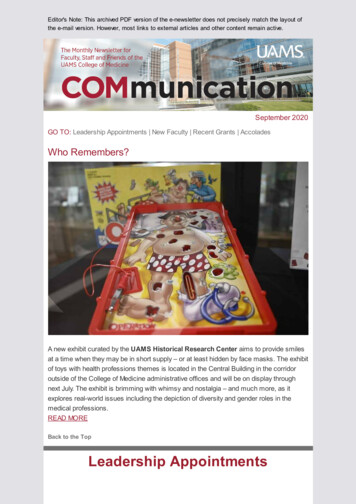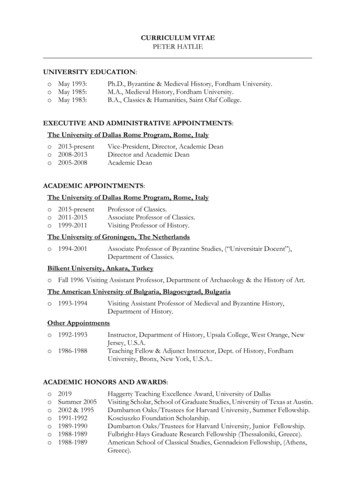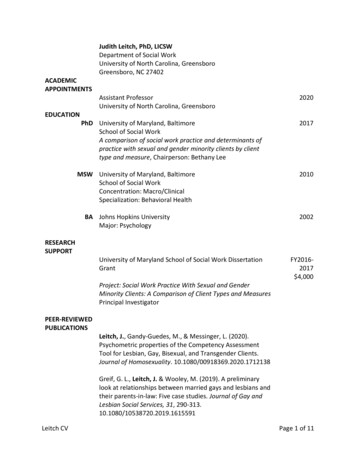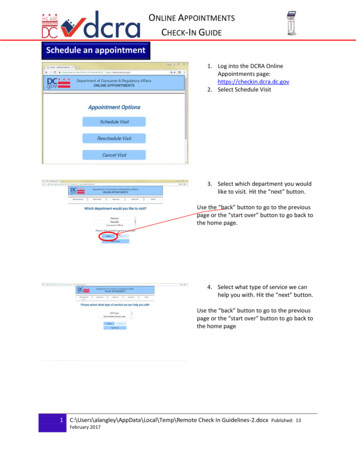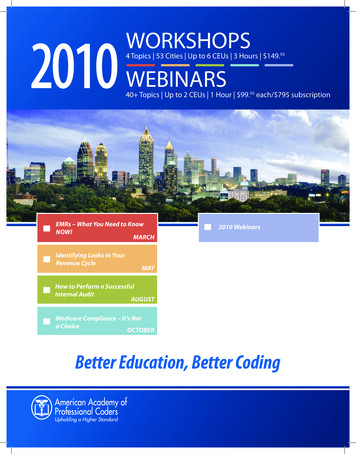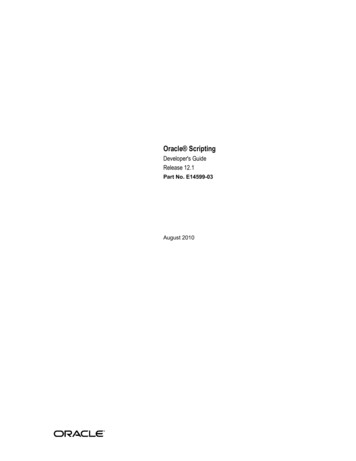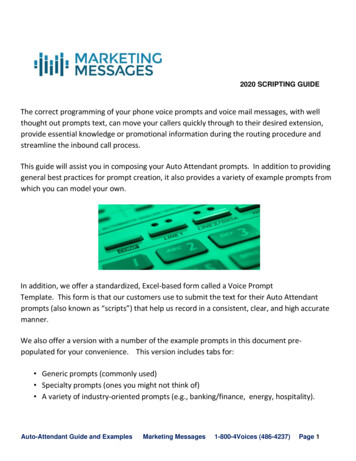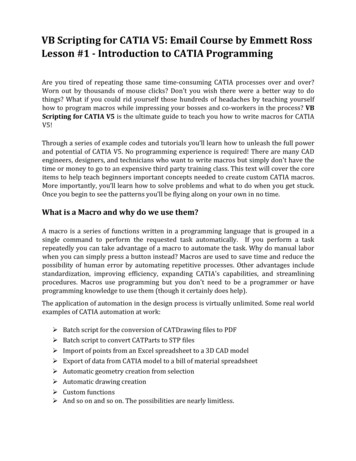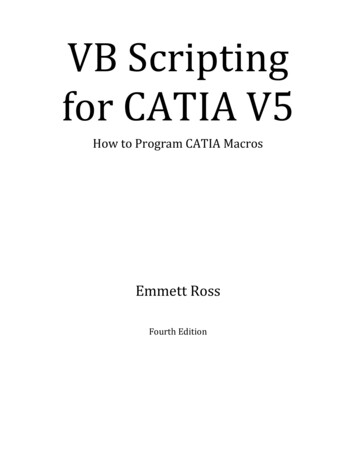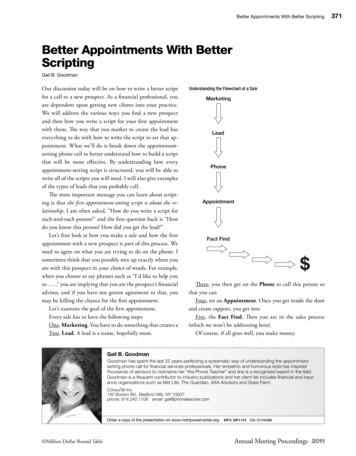
Transcription
Better Appointments With Better ScriptingBetter Appointments With BetterScriptingGail B. GoodmanOur discussion today will be on how to write a better scriptfor a call to a new prospect. As a financial professional, youare dependent upon getting new clients into your practice.We will address the various ways you find a new prospectand then how you write a script for your first appointmentwith them. The way that you market to create the lead haseverything to do with how to write the script to set that appointment. What we’ll do is break down the appointmentsetting phone call to better understand how to build a scriptthat will be more effective. By understanding how everyappointment-setting script is structured, you will be able towrite all of the scripts you will need. I will also give examplesof the types of leads that you probably call.The most important message you can learn about scripting is that the first appointment-setting script is about the relationship. I am often asked, “How do you write a script forsuch-and-such person?” and the first question back is “Howdo you know this person? How did you get the lead?”Let’s first look at how you make a sale and how the firstappointment with a new prospect is part of this process. Weneed to agree on what you are trying to do on the phone. Isometimes think that you possibly mix up exactly where youare with this prospect in your choice of words. For example,when you choose to say phrases such as “I’d like to help youto . . . ,” you are implying that you are the prospect’s financialadvisor, and if you have not gotten agreement to that, youmay be killing the chance for the first appointment.Let’s examine the goal of the first appointment.Every sale has to have the following steps:One, Marketing. You have to do something that creates aTwo, Lead. A lead is a name, hopefully more.Understanding the Flowchart of a SaleMarketingLeadPhoneAppointmentFact Find Three, you then get on the Phone to call this person sothat you canFour, set an Appointment. Once you get inside the doorand create rapport, you get intoFive, the Fact Find. Then you are in the sales process(which we won’t be addressing here).Of course, if all goes well, you make money.Gail B. GoodmanGoodman has spent the last 22 years perfecting a systematic way of understanding the appointmentsetting phone call for financial services professionals. Her empathic and humorous style has inspiredthousands of advisors to nickname her “the Phone Teacher” and she is a recognized expert in the field.Goodman is a frequent contributor to industry publications and her client list includes financial and insurance organizations such as Met Life, The Guardian, AXA Advisors and State Farm.ConsulTel Inc.150 Buxton Rd., Bedford Hills, NY 10507phone: 914.242.1108 email: gail@phoneteacher.comOrder a copy of the presentation on www.mdrtpowercenter.org: MP3: MP1153 CD: C1153AB Million Dollar Round TableAnnual Meeting Proceedings 2011371
372Focus Sessions: Sales IdeasIn order to understand the phone part of this process, it’simportant to clearly define an appointment. We’ll agree thatan appointment is a designated time, date, and place to meetface-to-face, with the purpose of deciding whether or notyou and the prospect want to have a new relationship or starta relationship, a relationship in which you are the financialadvisor and the prospect is the client.This is a critical part of understanding the phone call tothe prospect. If you have already set up the potential for thisrelationship because you had some kind of conversation (forexample, at a networking or social event) where both of youleft that conversation knowing you are going to meet, thenthe phone call WILL NOT follow the scripting we are covering today. The essence of that script will be one sentence:“Hi, this is Gail. I’ve got my calendar in front of me. What’sbest for you—this week or next?”When you use the flowchart, please understand that yourmarketing efforts (whether they are seminars, canvassing,trade shows, referrals, or whatever) are going to affect whatthe content of your script will be. And the most importantthing to remember is that the other person has not yet decidedhe or she wants a professional relationship with you. So youcannot use your sales words, that is, words that imply you aregoing to “help” them, when the prospect hasn’t yet decided ifyou are his or her financial helper. There is a tendency to really jump the gun by assuming that the prospect has alreadymade the decision to do business with you.Call ReluctanceThere are many managers and trainers who believe there issuch a thing as “call reluctance.” But there isn’t. I’ve spent20-plus years of my life trying to figure out why the peoplein my classes won’t get on the phone.And I’ve discovered that there are a couple of things thatare true. I find that most financial professionals share fourvery important traits:1. The first trait that they share is that they are smart.2. The second trait is that they are outgoing. They’revery people-oriented and social. They tend to be really good with other people, and they like to be withpeople. They’re not involved with machines; they’renot involved with the nonhuman environment. Peoplein sales love to be with other people.3. The third thing I know is true about them is that they’reverbal. They’re talkers! They like to talk and they tendto be better at talking than a lot of other people. Theyare the most verbally adept folks out there.Annual Meeting Proceedings 20114. The fourth trait is that salespeople who are commissioned tend to have a history of success and be ambitious to be successful. Most of the people I train arein the financial services business, and I work with alot of recruiters. They all tell me that even a youngcandidate must have a history of success in his orher endeavors.So we can summarize the financial services professionalas a good, smart talker. And if you put these people on aphone, and they think they are going to sound like blubbering idiots, they are not going to do it. It’s very hard for peopleto do anything that doesn’t match their self-image. Peoplewill not do an activity that is in conflict with their self-image. So if you have a verbally adept, smart person who feelsthat he or she is sounding stupid and tripping over words onthe phone, that person is not going to do it.I consider this a training opportunity. When people don’tfeel that they are properly trained or are going to sound sillyon the phone, it increases their anxiety. And when you’reanxious, you can’t be eloquent. So here you have a deadlycombination of smart, outgoing, talkative people feeling likethey are blubbering idiots. The only cure for call reluctanceis to provide people with a sense of competence (which increases their confidence) by providing proper phone training.Again, I don’t believe that there is such a thing as call reluctance. I feel that there are a lot of smart, talkative, outgoing salespeople who are anxious about the phone, need to betrained, need to practice, and also need to be fed the words.There isn’t a single professional athlete who would go outinto a field of any athletic play without being trained, without knowing what he or she is doing, without practicing, andwithout having a coach. So having all those things in placechanges the athlete’s experience. How do I know? BecauseI have been the coach. I have helped people prepare; I givethem scripts and they go running to the phones. Even if theydon’t make the appointments, they feel that they soundedbetter, and their confidence goes up.Am I a motivational speaker? No. I am a trainer, and Ifeel that when people are trained they are naturally motivated toward success. What happens after my classes is thatpeople go, “Aha! That’s what I’m supposed to be saying,” andthey are more willing to get on the phone.Scripting Versus Ad-LibbingLet’s start out by discussing why we all hate scripts. Here’swhat people say when I ask them, “Why don’t you like thescripts you’ve been given by your company?” Million Dollar Round Table
Better Appointments With Better Scripting They sound robotic.I feel like I’m reading.I sound like I’m reading.It doesn’t sound like me.It’s confining.I can’t respond to the client the way I want to.The message may not fit the client.I sound like a telemarketer.All those things are true. But now let’s compare scriptingto ad-libbing. What are the dangers of ad-libbing? You say “um” and “er” because you are thinking. You sound unprofessional. You might talk too much. You go out on tangents that don’t relate to getting an appointment. You miss the point of the call. You might be boring.We can agree that ad-libbing can be dangerous, but aninteresting truth to remember about ad-libbing is that youmay, in fact, say something brilliant! But because you adlibbed, you cannot capture the brilliant verbiage and thenrepeat it. By ad-libbing, you may be losing the best wordsyou accidentally say because they were not written down.So we have to find a happy medium between ad-libbing,going on tangents, just saying whatever comes to your mind,and being so confined by a script that you sound like a robotthat is spitting out words you would never use.The motto for good scripting is “Planned, not canned.”You need to know what you are going to say, and yet youmust be able to say something that fits your personality—and matches what you need to say to that particular prospect. Let’s talk about how to construct a script and yet putyour own personality into it. It’s important to think in termsof good phrases instead of learning scripts by heart. I am nota big fan of memorizing a script unless you can memorize itbut say it out loud in a natural way. Most people do a wholelot better by listing the key phrases in the script and thenusing their natural talking ability to get their message across.Mr. Potato HeadThere are seven components in a good phone script. Inthinking about scripting, I want you to think of the gameMr. Potato Head. Mr. Potato Head is great because it teacheschildren the structure of the face, but it also teaches themthat there are options. Eyes can be blue or green or brown,but eyes always go in the same place on a face. If you look ata room of people, all of the faces are structured the same, but Million Dollar Round Tablethere’s variety in the structure. That philosophy applies wellto scripting. All scripts have the same structure, but withinthat structure there is room for personalizing.The components stay the same, but as with most things,there is one exception. One element moves depending oncertain factors, and I will explain which one that is and why.For each of these components, we will give it a name andshare the options you can use. This will give you a goodstructure to work with, but you will be allowed to plug inyour own personal style.Components of a Phone ScriptA good phone script includes seven components. Each of theseseven components appears in the same order in all of yourphone calls—with one exception. For each of them, there areoptions you can use to allow for your own verbal style.The seven parts of a script are A, B, C, D, E, F, and G.We will go through each slowly so that you can see how theywork together, how you can personalize each one, and howyou have to change certain components so that you are making sense to the type of prospect you are calling.Remember some key things about scripting: One, dumbdown. All of you use so many big, polysyllabic financialwords you are in love with, but those are not as good to use onthe phone as the simpler words. Two, only use concepts thatwould be readily understood by a 14-year-old, Americanborn child who has grown up in our culture. These teenagersare pretty sophisticated, but they don’t go around talkingabout “wealth accumulation”; they would better understand“saving money.” On the phone, these long-winded phrasesdon’t work well.What is the purpose of the call? To get in front of theprospect and have an initial appointment whereby you aremaking the decision to start a relationship or, for those whoalready know you, add a new relationship. And in this relationship, you are the financial advisor and he or she is the client. Ifyou forget what the purpose of the call is, then you will useall kinds of sales words that don’t belong.Let’s go through the components:A is your greeting.What is the first thing you say when you reach the prospect? “Hello,” “Hi,” “Good morning,” Good afternoon,” or“Good evening.” Do not to use any slang words or phrases.Always adhere to a professional manner of speaking whenusing the phone. Certain parts of the country have localgreetings that may be used when appropriate. “Hey” is usedAnnual Meeting Proceedings 2011373
374Focus Sessions: Sales Ideasin the Mid-Atlantic states (Maryland, Virginia, and Northand South Carolina) but might be inappropriate in otherareas of the country.B is when you introduce yourself.There are four ways to introduce yourself. The most popularis to say, “This is.” The second is to simply say, “I’m.” The third way, for people you knowvery well, is to say, “It’s.” Avoid introducing yourself by saying, “My name is,”which is the fourth possible introduction. It indicates to theprospect that the caller is a stranger or a telemarketer. Thisintroduction merely increases the initial tension.C is your company.This is the component that is the “moveable object.” The position of C is dependent on the D (which we’ll get to shortly).You have to get out of the habit of saying the first threecomponents as if they were glued together: “Hi-this-is-GailGoodman-with-ABC-Financial” is a bad habit. You are going to separate your company name from your name becauseyou may, in fact, mention your company after you say the D.For the C, you might say, “with ABC Financial” or “fromABC Financial,” or when you call orphan policyholdersfrom your company you would add “I’m calling from theAtlanta office of ABC Fin
appointment-setting script is structured, you will be able to write all of the scripts you will need. I will also give examples of the types of leads that you probably call. The most important message you can learn about script-ing is that the first appointment-setting script is about the re-lationship. I am often asked, “How do you write a script forFile Size: 319KBPage Count: 6
